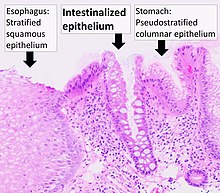Metaplasia
[1] The change from one type of cell to another may be part of a normal maturation process, or caused by some sort of abnormal stimulus.
If the stimulus causing metaplasia is removed or ceases, tissues return to their normal pattern of differentiation.
Metaplastic change is thus often viewed as a premalignant condition that requires immediate intervention, either surgical or medical, lest it lead to cancer via malignant transformation.
Thus, at sites where abnormal metaplasia is detected, efforts are made to remove the causative irritant, thereby decreasing the risk of progression to malignancy.
The metaplastic area must be carefully monitored to ensure that dysplastic change does not begin to occur.

